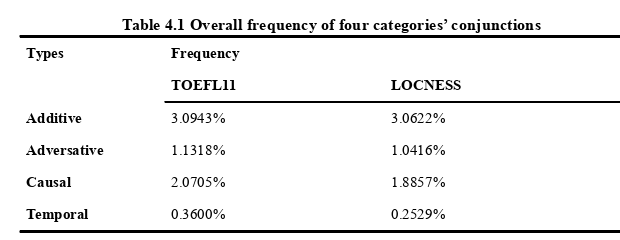联系方式
more本类最新英语论文
- 2024-04-21基于语料库的国际经济期刊概..
- 2024-04-15女性主义视角下《占有》中的..
- 2024-03-30空间三一论视域下《失乐园》..
- 2024-03-27乔纳森·弗兰岑小说《自由》..
- 2024-03-24伊恩·麦克尤恩《追日》中的..
- 2024-03-23菲利普·罗斯《复仇女神》中..
- 2024-03-16人类独特属性丧失的寓言——..
- 2024-03-10“澳大利亚的声音”——论亨..
- 2024-03-09拉康三界说视域下《灿烂千阳..
- 2024-03-02古尔纳非洲反成长小说思考
more热门文章
- 2010-12-24关于教育理论的实用性研究:..
- 2010-02-25influence of anxiety on e..
- 2010-08-05results and analysis
- 2011-08-23英语硕士论文范文-代写英语..
- 2010-12-21阅读技巧的培养:impove st..
- 2014-09-19工业与学术之间的差距 英语..
- 2010-12-26英国英语与美国英语之差异:..
- 2010-12-15tesol教育硕士课程和多样化..
- 2014-07-25英国论文范文—资产证券化在..
- 2010-12-24如何设计教学活动提高学生口..
more留学论文写作指导
- 2024-03-31卡森•麦卡勒斯小说中..
- 2024-03-28美国黑人女性心理创伤思考—..
- 2024-03-27乔治·艾略特《织工马南》中..
- 2024-03-21超越凝视:论《看不见的人》..
- 2024-03-19《哈克贝利•费恩历险..
- 2024-03-13心灵救赎之旅——从凯利的三..
- 2024-02-22文学地理学视角下的《印度之..
- 2023-05-03英、汉名词短语之形容词修饰..
- 2023-02-07目的论视域下5g—the futur..
- 2022-07-04二语英语和三语日语学习者的..
基于语料库的中国英语学习者与本族语者写作连接词的使用对比探讨 [3]
论文作者:留学生论文论文属性:硕士毕业论文 thesis登出时间:2022-04-22编辑:vicky点击率:2014
论文字数:49855论文编号:org202204182153151594语种:英语 English地区:中国价格:$ 66
关键词:英语论文范文
摘要:本文是一篇英语论文范文,根据研究问题,主要发现如下。首先,从表4.6可以看出,中国英语学习者使用连词的频率高于母语人士。但是在某些连词的使用上,母语人士使用它们的频率更高,比如“还”、“然后”。学习者和母语人士在连词的位置和搭配上既有差异,也有一些相似之处。
Chapter Four Results and Discussion............................... 17
4.1 Differences of conjunctions use in TOEFL11 and LOCNESS...................... 17
4.1.1 Frequency of conjunctions..........................17
4.1.2 Position and collocation of conjunctions......................... 23
Chapter Five Conclusion...........................76
5.1 Research findings...................................76
5.2 Implications and limitations..........................78
Chapter FourResults and Discussion
4.1Differences of conjunctions use in TOEFL11 and LOCNESS
In this part, the first research question is analyzed. The frequency of conjunctions areretrieved according to their classification, then the position and collocation of conjunctionsare analyzed in detail.
4.1.1 Frequency of conjunctions
This section shows the comparison of conjunctions’ frequency between Chinese Englishlearners and native speakers.
4.1.1.1 Overall frequency of conjunctions
After the retrieval of conjunctions in WordSmith Tools 6.0, the frequency of everyconjunction is calculated. Table 4.1 shows the overall frequency of additive, adversative,causal and temporal conjunctions used by learners and native speakers.

As can be seen from Table 4.1, the frequency of four categories’ conjunctions by learnersis higher than that by native speakers. The following parts list the frequency comparison ofeach type of conjunctions between learners and native speakers.
Chapter Five Conclusion
5.1Research findings
According to research questions, main findings are listed as follows.
Firstly, the frequency of conjunctions by Chinese English learners is higher than that bynative speakers, which can be seen from Table 4.6. But in the use of some conjunctions,native speakers use them more frequently, such as yet, and then. There are differences as wellas some similarities in the position and collocation of conjunctions between learners andnative speakers. As for the position of conjunctions, the position of all conjunctions is nearlythe same in two corpora, mainly used at the beginning and in the middle of sentences, exceptat the same time, so, as a result, for instance and finally which are not only used at thebeginning and in the middle, but also at the end of sentences. Although the position ofconjunctions in two corpora is nearly the same, the frequency of occurring at the beginning, inthe middle or in the end is different. For example, native speakers use hence more times in themiddle, while learners tend to put it more times at the beginning position. With regard to thecollocation of conjunctions, high frequency collocates of all conjunctions are firstly somefunction words, such as propositions and articles. The, to and of are usually the top threecollocates of most conjunctions in two corpora. However, specific collocations ofconjunctions in two corpora are different to a large extent. Some of the examples are asfollows.
When it comes to and not, the collocation with facts is found in TOEFL11. Learners useand not to lin本论文由英语论文网提供整理,提供论文代写,英语论文代写,代写论文,代写英语论文,代写留学生论文,代写英文论文,留学生论文代写相关核心关键词搜索。

 英国
英国 澳大利亚
澳大利亚 美国
美国 加拿大
加拿大 新西兰
新西兰 新加坡
新加坡 香港
香港 日本
日本 韩国
韩国 法国
法国 德国
德国 爱尔兰
爱尔兰 瑞士
瑞士 荷兰
荷兰 俄罗斯
俄罗斯 西班牙
西班牙 马来西亚
马来西亚 南非
南非






